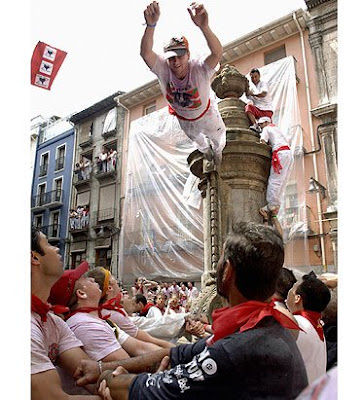O Gerente, Chico Garcia e Duarte Cortes, vão nesta digressão de 2008, igualar o número de presenças consecutivas na maior festa do mundo, do famoso Ernest Hemingway. Olé!
Hemingway and Pamplona
Ernest Hemingway (1899-1961) came to Pamplona for the first time, travelling from Paris, on the 6th of July 1923, in the full swing of the Fiesta of San Fermin. The atmosphere in the city and, particularly, the gratuitous contest between man, bull and death made such an impression on him that he chose the fiesta as the backdrop to his first successful novel, "The Sun Also Rises", published three years later. Hemingway returned to the Fiesta of San Fermin eight times after that. His last visit was in 1959, five years after winning the Nobel Prize for Literature and two before his suicide in Ketchum (Idaho), on the eve of San Fermin.
The great American writer brought international fame to Pamplona’s fiesta. His contribution was decisive in converting a simple local festivity, practically unheard of abroad, into one of the world"s most famous celebrations and the destination ever since for thousands and thousands of foreign tourists, many seduced by his pen.
Many of the establishments which Hemingway frequented during his visits to the capital of Navarre can still be visited today: Bar Txoko, Hotel La Perla and Café Iruña, all in the Plaza del Castillo, and Hotel Yoldi, the bullfighters’ hotel. Other stop-off points on the “Hemingway route”, such as Hotel Quintana, Café Suizo or Casa Marceliano, have, however, disappeared.
During that time, the novelist attended the Fiesta of San Fermin almost without fail. He came in 1923, 1924, 1925, 1926, 1927, 1929 and 1931. Following the parenthesis of the Spanish Civil War, in which he actively participated for the Republican cause, and WWII, he came back twice: 1953 and 1959. If anything can be said of Hemingway’s time in Pamplona, it is that he never came as a distant onlooker; the author lived the fiestas to the full, submerging himself totally in the atmosphere, as befitted his passionate and intensely vital temperament.
This representative of the so-called “lost generation” ran before the bulls, made friends with bullfighters -such as Antonio Ordóñez- and locals -such as Juanito Quintana-, ate, drank and lived with the locals, and experienced in their company the joy, heat and euphoria unique to the Fiesta of San Fermin... But he also saw the tragic side of the celebrations: he was witness to the first recorded death of a runner at the horns of a bull, 22-year-old Esteban Domeño, in 1924. Hemingway recounted this dramatic episode in The Sun Always Rises. Death in the Afternoon (1932) is also set in the bullfighting world.
Pamplona City Council paid tribute to Ernest Hemingway on the 6th of July 1968, unveiling a monument made by Luis Sanguino on the Paseo next to the Bullring bearing his name. His last wife, Mary Welsh, attended the event. The following dedication is recorded on the base of monument: A Ernest Hemingway, Premio Nobel de Literatura, amigo de este pueblo y admirador de sus fiestas, que supo descubrir y propagar (To Ernest Hemingway, Nobel Laureate in Literature, friend of this city and admirer of its fiestas, which he discovered and brought fame to). La Ciudad de Pamplona, San Fermín, 1968 (The City of Pamplona, San Fermin, 1968).
Many other famous figures have followed in Hemingway’s footsteps: among others, the film director Orson Welles, the actress Ava Gardner, Margeaux Hemingway, the writer’s granddaughter and, more recently, the playwright Arthur Miller, the photographer Inge Morat and Antillean Nobel Literature Laureate Derek Walcott.















